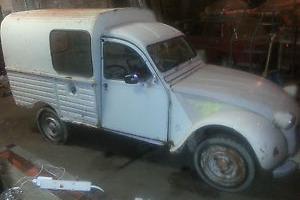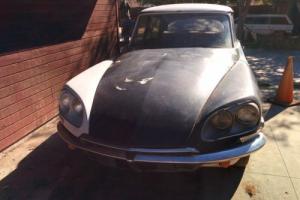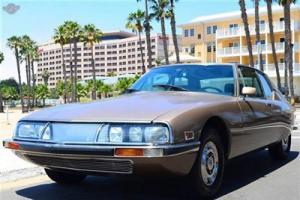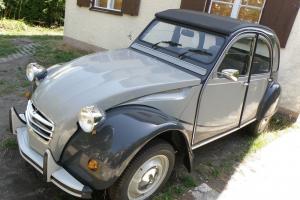Classic Cars / Citroen / Car for sale
1982 CITROEN 2CV CHARLESTON
Sale price: $13,500.00 Make an offer
Car location: United States
Seller's notes: "Excellent condition in and out. Complete restoration using original new parts. New paint and side body vinyl design. New soft top. Passed rigorous German TUV Inspection. The car is in Munchen Germany, and can be shipped anywhere in the world. The shipping fee is not included in the selling price.Mileage shown is kilometers."
Sale type: Fixed price listing
Technical specifications, photos and description:
- Make:
- Citroen
- Model:
- CHARLESTON
- Year:
- 1980
- Type:
- Convertible
- Color:
- Gray
- Mileage:
- 87,000
- Engine:
- 602 cc
- Transmission:
- Manual
- Fuel Type:
- Gasoline
- Trim:
- 4 door
- Interior Color:
- Gray
- Vehicle Title:
- Clear
- Got questions?
- Ask here!
1982 CITROEN 2CV CHARLESTON for sale
Current customer rating:
The Citroën 2 CV (French: "deux chevaux" i. e. "deux chevaux-vapeur" (lit. 'steam horses'). "two tax horsepower") was an economy car produced by the French car manufacturer Citroën between 1948 and 1990. [1] It was technologically advanced and innovative. but with uncompromisingly utilitarian unconventional looks. and deceptively simple Bauhaus and Junkers early all metal aircraft inspired bodywork (corrugated for added strength without added weight). that belied the sheer quality of its underlying engineering.
It was designed to motorize the large number of small-holder farmers in 1930 s France. who were still using horses and carts. It is considered one of Citroën's most iconic cars. Only a few thousand 2 CVs were sold in North America when they were new as in England their pricing was excessive relative to competitors.
The original model that produced just 9 hp (6. 7 k W) and had a top speed of only 64 km/h (40 mph) (even the fastest of the later models struggled to 115 km/h (71 mph))[30] was unsuited to the expanding post-war US freeway network. and was never widely accepted in North America. unlike the Volkswagen Beetle. which was designed with Autobahns in mind and could reach speeds of over 115 km/h (and later versions were faster still).
Citroën was marketed as a luxury brand after the launch of the mid-1950 s Citroën DS in North America. and the importers did not actively promote the 2 CV. as doing so would undermine the brand image.
The level of technology in the 1948 2 CV was remarkable for a car of any price in that era. let alone one of the cheapest cars on the planet.
While colors and detail specifications were modified in the ensuing 42 years. the biggest mechanical change was the addition of front disc brakes in 1981.
The reliability of the car was enhanced by the minimalist simplification of the designers. being air-cooled (with an oil cooler). it had no coolant. radiator. water pump or thermostat. It had no distributor either. just a contact breaker system.
Except for the all hydraulic brakes. there were no hydraulic parts on original models as damping was by tuned mass dampers and friction dampers.
The suspension of the 2 CV was almost comically soft a person could easily rock the car side to side dramatically.
Front-wheel drive made the car easy and safe to drive and Citroën had developed expertise with it due to the pioneering Traction Avant. which was the first mass-produced steel monocoque front-wheel-drive car in the world.
Unlike other air-cooled cars the 2 CV's engine had (for simplicity and reliability) no thermostat. valve fitted to its oil system to allow the oil to reach normal operating temperature quickly in cold weather. All the oil in the system passed through an oil cooler mounted behind the fan and received the full cooling effect regardless of the ambient temperature.
This removes the risk of overheating from a jammed thermostat that can afflict water- and air-cooled engines and the engine can withstand many hours of running under heavy load at high engine speeds even in hot weather.
These design features made the 2 CV engine highly reliable test engines were run at full speed for 1000 hours at a time. equivalent to driving 80. 00 km (50. 00 mi) at full throttle.
They also meant that the engine was very much "sealed for life"—for example. replacing the big-end bearings required specialized equipment to dismantle and reassemble the built-up crankshaft. and as this was often not available the entire crankshaft had to be replaced.
However. the engine is very under-stressed and long-lived. so this is not a major issue. Until the 1960 s it was common for other car manufacturers' engines to need full strip downs and rebuilds at as little as 80. 00 km (50. 00 mi) intervals un-rebuilt 2 CV engines are still running that are passing 400. 00 km (250. 00 mi).
When asked about the 2 CVs performance and acceleration. many owners said it went "from 0–60 in one day". Others jokingly said they "had to make an appointment to merge onto an highway.
The original 1948 model that produced only 9 hp
had a 0-40 time of 42. 4 seconds and a top speed of just 64 km/h (40 mph). far below the speeds necessary for North American highways or the German Autobahns of the day. The top speed increased with engine size to 80 km/h (49 mph) in 1955. 84 km/h (52 mph) in 1962. 100 km/h (63 mph) in 1970. but was finally not capable of US freeway speeds of 115 km/h (71 mph) until 1981.
The 2 CV has also been used for travel around the world.
In 1958–1959. two young Frenchmen. Jean-Claude Baudot and Jacques Séguéla started at the Paris Motor Show on October 9. 1958 headed south and crossed the Mediterranean Sea by boat from Port Vendres to Algeria traversed the African continent and crossed the S. Atlantic from Cape Town to Reo de Jeneiro criss-crossed South America and the United States and boated from San Francisco to Yokohama.
They returned to Paris on November 11. 1959. During the 13 months. they drove 100. 00 kilometers. and consumed 5000 litres of petrol and 36 tires.
It was designed to motorize the large number of small-holder farmers in 1930 s France. who were still using horses and carts. It is considered one of Citroën's most iconic cars. Only a few thousand 2 CVs were sold in North America when they were new as in England their pricing was excessive relative to competitors.
The original model that produced just 9 hp (6. 7 k W) and had a top speed of only 64 km/h (40 mph) (even the fastest of the later models struggled to 115 km/h (71 mph))[30] was unsuited to the expanding post-war US freeway network. and was never widely accepted in North America. unlike the Volkswagen Beetle. which was designed with Autobahns in mind and could reach speeds of over 115 km/h (and later versions were faster still).
Citroën was marketed as a luxury brand after the launch of the mid-1950 s Citroën DS in North America. and the importers did not actively promote the 2 CV. as doing so would undermine the brand image.
The level of technology in the 1948 2 CV was remarkable for a car of any price in that era. let alone one of the cheapest cars on the planet.
While colors and detail specifications were modified in the ensuing 42 years. the biggest mechanical change was the addition of front disc brakes in 1981.
The reliability of the car was enhanced by the minimalist simplification of the designers. being air-cooled (with an oil cooler). it had no coolant. radiator. water pump or thermostat. It had no distributor either. just a contact breaker system.
Except for the all hydraulic brakes. there were no hydraulic parts on original models as damping was by tuned mass dampers and friction dampers.
The suspension of the 2 CV was almost comically soft a person could easily rock the car side to side dramatically.
Front-wheel drive made the car easy and safe to drive and Citroën had developed expertise with it due to the pioneering Traction Avant. which was the first mass-produced steel monocoque front-wheel-drive car in the world.
Unlike other air-cooled cars the 2 CV's engine had (for simplicity and reliability) no thermostat. valve fitted to its oil system to allow the oil to reach normal operating temperature quickly in cold weather. All the oil in the system passed through an oil cooler mounted behind the fan and received the full cooling effect regardless of the ambient temperature.
This removes the risk of overheating from a jammed thermostat that can afflict water- and air-cooled engines and the engine can withstand many hours of running under heavy load at high engine speeds even in hot weather.
These design features made the 2 CV engine highly reliable test engines were run at full speed for 1000 hours at a time. equivalent to driving 80. 00 km (50. 00 mi) at full throttle.
They also meant that the engine was very much "sealed for life"—for example. replacing the big-end bearings required specialized equipment to dismantle and reassemble the built-up crankshaft. and as this was often not available the entire crankshaft had to be replaced.
However. the engine is very under-stressed and long-lived. so this is not a major issue. Until the 1960 s it was common for other car manufacturers' engines to need full strip downs and rebuilds at as little as 80. 00 km (50. 00 mi) intervals un-rebuilt 2 CV engines are still running that are passing 400. 00 km (250. 00 mi).
When asked about the 2 CVs performance and acceleration. many owners said it went "from 0–60 in one day". Others jokingly said they "had to make an appointment to merge onto an highway.
The original 1948 model that produced only 9 hp
had a 0-40 time of 42. 4 seconds and a top speed of just 64 km/h (40 mph). far below the speeds necessary for North American highways or the German Autobahns of the day. The top speed increased with engine size to 80 km/h (49 mph) in 1955. 84 km/h (52 mph) in 1962. 100 km/h (63 mph) in 1970. but was finally not capable of US freeway speeds of 115 km/h (71 mph) until 1981.
The 2 CV has also been used for travel around the world.
In 1958–1959. two young Frenchmen. Jean-Claude Baudot and Jacques Séguéla started at the Paris Motor Show on October 9. 1958 headed south and crossed the Mediterranean Sea by boat from Port Vendres to Algeria traversed the African continent and crossed the S. Atlantic from Cape Town to Reo de Jeneiro criss-crossed South America and the United States and boated from San Francisco to Yokohama.
They returned to Paris on November 11. 1959. During the 13 months. they drove 100. 00 kilometers. and consumed 5000 litres of petrol and 36 tires.
Want to buy this car?
Comments and questions to the seller:
Other classic Citroen cars offered via internet auctions:
 price: $2,000.00Citroen AK400
price: $2,000.00Citroen AK400 price: $US $880.001968 Citroën
price: $US $880.001968 Citroën price: $13,415.0073 Euro SM, 5 speed, A/C. 45,000 miles, tons of Records
price: $13,415.0073 Euro SM, 5 speed, A/C. 45,000 miles, tons of Records price: $US $1,500.001938 Citroën Traction Avant
price: $US $1,500.001938 Citroën Traction Avant
Latest arrivals:
-
$1.000
-
$1,000.000
-
$5,600.000
-
$2,550.000
-
$50,000.000
-
$50,000.000
-
$2,000.000
-
$24,977.000
-
$12,900.000
-
$23,900.000
-
$14,500.000
-
$19,999.000
-
$19,999.000
-
$26,900.000
-
$11,101.000
-
$30,000.000
-
$37,900.000
-
$29,900.000
-
$21,900.000
-
$1,000.000


























